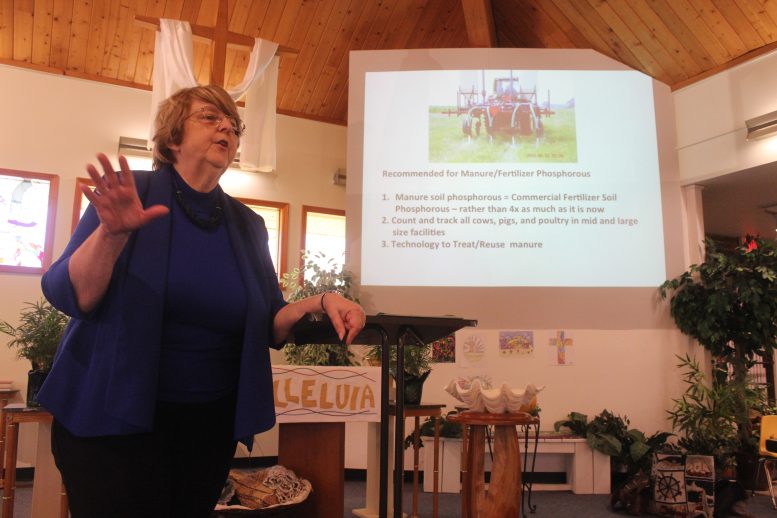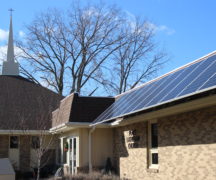By DAVID DUPONT
BG Independent News
Factory farms, corporations and kids can all help address concerns about pollution in Lake Erie.
That was one of the message that came out of the third Creation Care Celebration Sunday Peace Lutheran Church. Sponsored by the Black Swamp Green Team, the event encourages looking at environmental issues through a spiritual lens.
That’s something that’s needed said keynote speaker Sandy Bihn, executive director of the Lake Erie Foundation, and founder of Lake Erie Waterkeeper. It is important for all faith communities to come together to protect our sources of water.
The Maumee River Watershed is central to that effort. Lake Erie, especially the western basin, suffer from algae growth promoted by the phosphorus from manure and fertilizer flowing from the regions’ vast farmlands. Much of it finds its way to Lake Erie. And under the right conditions that algae can produce the deadly microcystin toxin. That toxic algal growth is what shut off the Toledo’s water supply in summer, 2014.
And though $20 billion have been spent to protect the lake, those phosphorus levels have not gone down, Bihn said.
She likened Lake Erie to the proverbial canary in the coal mine. Because it is so shallow, it is the first to exhibit, problems, Bihn said. However, that also means that the water in the lake is replenished within a matter of weeks, or in the case of the western basin a matter of days.
However, Bihn said, once these problems begin to manifest themselves in the larger lakes, they will take much longer to remedy.
Lake Erie has come back since the nadir in the 1960s.
That came about because of government action to invest on better water treatment systems. States also moved to ban phosphorus in detergent.
Despite the evident problems in Ohio, Bihn noted, the state lagged behind others in banning the phosphorus in laundry detergent, waiting until 1988, some 17 years after Michigan. Procter and Gamble, with headquarters in Ohio, fought the ban. However, Bihn said, two decades later when a ban on phosphorus in dishwashing liquid was proposed, the company got on board from the beginning.
Now the major problem, she said, comes from agriculture. The ditches and field tiles that made the Black Swamp tillable, also mean the water’s flow to the lake is expedited. Manure contributes 27 percent of the phosphorus, and commercial fertilizer contributes 33 percent. But addressing those two sources take different approaches.
Farmers must buy commercial fertilizers, so it is in their economic interest to minimize their use. Manure, however, is a waste product that needs to be disposed of, so spreading as much as possible on fields is an economic gain. Factory dairy farms and concentrated feeding operations produce a lot of manure.
Now four times as much manure is used as commercial fertilizer. If those numbers were equal, she said, that could greatly reduce phosphorus levels in the lake.
The point is “only put on as much as the crop needs,” Bihn said.
That requires new technology for treating and using manure as well as better monitoring of the cows and pigs raised on medium and large operations.
But even those who don’t own cows or pigs can do their part to address the problem, said Amanda Gamby, the newly hired sustainability coordinator for the City of Bowling Green.
Properly taking pets’ waste, or pets’ poo, a term that tickles the younger set, is an important step, she said.
That’s one way youngsters can be green superheroes, she said. Simple steps like not running the water while brushing teeth can also help, as can volunteering to pick up trash.
Homeowners can look to put in rain gardens or native plants. Native plants are better adapted to the clay soil found in the area. Their roots go deep into the ground, bringing the water deep in the soil. That slows the flow of water and whatever contaminants it carries to the lake.
Retired philosophy Professor Don Scherer said that is why native plantings are going to be cultivated at the site of the city’s solar array. This will remove the need for mowing.
Even though no longer used for farming, the property does still have residue, he said.
Around the perimeter will be flowers that will attract bees, butterflies and other insects that help pollinate crops. Bees can travel as far as three miles.
The planting will begin in the fall.



